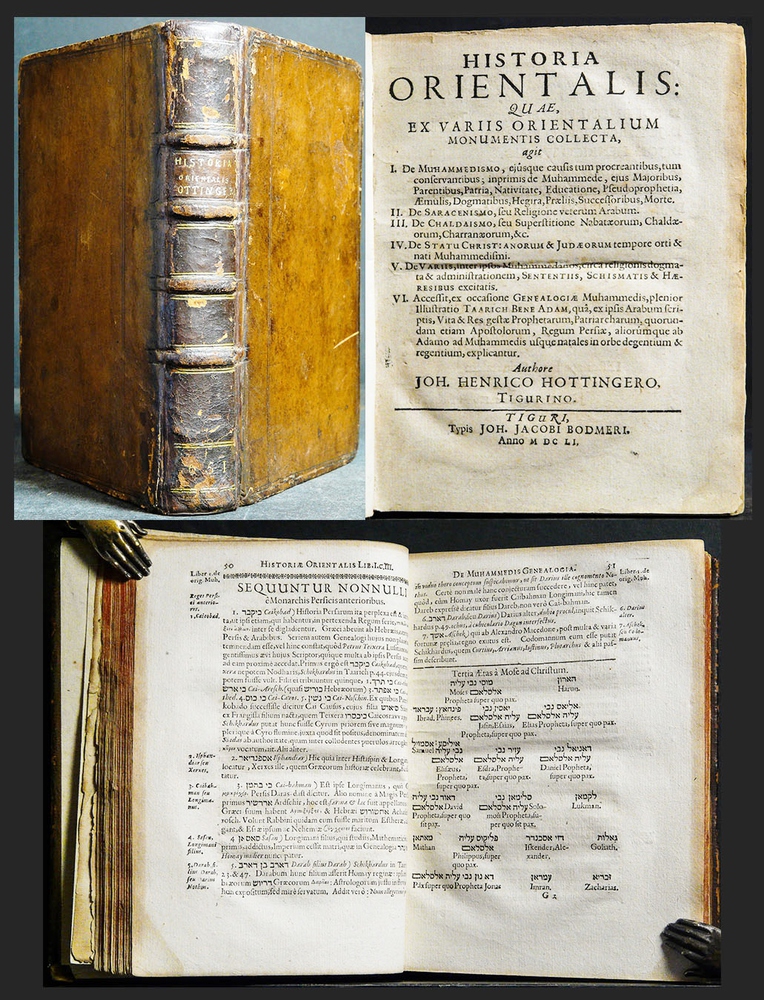Hottingero, Johann Heinrich (1620-1667): Historia orientalis quae ex variis orientalium monumentis (1651)
€1.200,00
Johann Heinrich HOTTINGER (1620-1667)
Historia orientalis quae ex variis orientalium monumentis collecta, agit I. De Muhammedismo…, II. De Saracenismo…, III. De Chaldaismo …, IV. De statu Christianorum & Judaeorum tempore orti & nati Muhammedism. V. De variis, inter ipsos Muhammedanos, VI. Accessit, ex occasione Genealogiae Muhammedis
Tiguri (Zürich), Typis Joh. Jacobi Bodmeri, Anno MDC.LI (1651)
Description: [in 4to] – pp. (16), 373, (23), (b). ORIGINAL EDITION
A rare and remarkably well preserved copy of this important work on the origins of Islam and progression of the philosophy, doctrine and teachings of Mohammed in the middle east. It covers the the entire life of Mohammed, analizes his teachings putting them in historical perspective with the old Arab traditions, Saracenism, but also Chaldaism and the overall state of Christianity and Judaism at the time of Mohammed. A prominent orientalist
Johann Heinrich Hottinger (1620-1667) studied at Geneva, Groningen and Leiden. He was appointed professor of Ecclesiastical history in his native town of Zürich in 1642. The chair of Hebrew at the Carolinum was added in 1643, and in 1653 he was appointed professor ordinarius of logic, rhetoric and theology. He gained such a reputation as an Oriental scholar that the elector palatine in 1655 appointed him professor of Oriental languages and Biblical Criticism at the University of Heidelberg. In 1661 he returned to Zürich, where in 1662 he was appointed principal of the University of Zürich. In 1667 he accepted an invitation to succeed Johann Hoornbeck (1617-1666) as professor in the University of Leiden. His son, Johann Jakob Hottinger (1652-1735), who became professor of theology at Zürich in 1698, was the author of a work against Roman Catholicism, Helvetiscize Kirchengeschichte (4 vols, 1698-1729). In the first pages of the ‘Dedicatio’ of his work Hottinger gives an elaborate justification of his undertaking, He appeals to some celebrated predecessors and to learned colleagues who have expressly instigated him to this work, amongst other things he quotes a letter from a prominent Leiden professor in which he conjures Breitinger by the bowels of Jesus Christ (“per viscera Jesu Christi”) to give the young man every opportunity to complete his study of the religion of Mohammed, “which so far has only been treated in a senseless way” also aimed at a better understanding of the christian holy scriptures extending and deepening the knowledge of Oriental manners, tradition and doctrine. Besides such promotion of Christian exegesis and apologetics and the improvement of the works on general history, Hottinger himself contemplated a double purpose in his Historia Orientalis. The Roman Catholics often vilified Protestantism by comparing the Reformed doctrine to that of Mohammedanism; this reproach Hottinger wished to fling back at the Catholics; and he devotes a whole chapter (Chap. 6) of his book to the demonstration that Bellarminius’ proofs of the truth of the Church doctrine might have been copied from the Moslem dogma. In second place, conforming to the spirit of the his times, he wished, just as Bibliander had done in his refutation of the Qoran, to combine the combat against Mohammedan unbelief with that against the Turkish Empire (“in oppugnationem Mahometanæ perfidiæ et Turcici regni”). The Turks were feared by the Europe of that time, and the significance of their religion for their worldly power was well known; thus the political side of the question gave Hottinger’s work a special claim to consideration. Yet, in spite of all this, Hottinger feared that his work would be regarded as wicked he thinks it necessary to protect himself against misconstruction by the addition of some selected periphrasis especially when directly mentioning Mohammed or his followers such as “at the mention of whom the soul horrify” (“ad cujus profecto mentionem inhorrescere nobis debet animus”).
Among his other works are Historici ecclesiastica Nov. Test. (1651-1667); Thesaurus philologicus seu davis scripturae (1649; 3rd ed. 1698); Etymologicon orientale, sive lexicon harmonicum heptaglotton (1661), Promptuarium sive bibliotheca Orientalis (1658).
Contemporary full leather binding with four raised bands, hand written titles in gold in small block letters at the second compartment from top and red edges . In the overall a very clean copy, good interiors with minor spotting, a contemporary hand written ownership note at the first endpaper. Text mainly in latin in beautiful tondo and italic script with many sections and quotations printed with Hebraic typeface and to a lesser extent in Greek. Woodcut typographical decorations including some decorated intials and head and tail pieces.
A complete copy of this rare work in its first impression.
Cfr.: J.C. BRUNET, Manuel du Libraire et de l’amateur de Livres. IV ed. , Paris, Chez Silvestre (1842), Vol. II, 650-651 ; SNOUCK HURGRONJE, Mohammedanism, lectures on its origin, its religious and political growt and its present state, NY, New York, Putnam’s sons (1937) , pp. 1-54; NUC, National Union Catalogue , London, Mansell, (1968-1981) , CCLVI, 7




